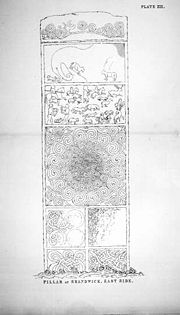
Clach a' Charridh
Encyclopedia

Pictish stones
Pictish stones are monumental stelae found in Scotland, mostly north of the Clyde-Forth line. These stones are the most visible remaining evidence of the Picts and are thought to date from the 6th to 9th centuries, a period during which the Picts became Christianized...
located near Shandwick
Shandwick
Shandwick , a village near Tain in Easter Ross, and is in the Scottish council area of Highland, Scotland.Hilton, Balintore, and Shandwick are known collectively as the Seaboard Villages. It is well-known because of the nearby Clach a' Charridh or Shandwick Stone, a Class II Pictish stone.-External...
on the Tarbat peninsula in Easter Ross
Easter Ross
Easter Ross is a loosely defined area in the east of Ross, Highland, Scotland.The name is used in the constituency name Caithness, Sutherland and Easter Ross, which is the name of both a British House of Commons constituency and a Scottish Parliament constituency...
, Scotland
Scotland
Scotland is a country that is part of the United Kingdom. Occupying the northern third of the island of Great Britain, it shares a border with England to the south and is bounded by the North Sea to the east, the Atlantic Ocean to the north and west, and the North Channel and Irish Sea to the...
.

Carving
It is a Class II stone, with the crossCross
A cross is a geometrical figure consisting of two lines or bars perpendicular to each other, dividing one or two of the lines in half. The lines usually run vertically and horizontally; if they run obliquely, the design is technically termed a saltire, although the arms of a saltire need not meet...
facing the seaward side, and the secular scene facing inland. The latter contains six panels, the first (from top to bottom) being a standard Pictish double-disc, the second being a Pictish Beast
Pictish Beast
The Pictish Beast is an artistic representation of an animal, and is depicted on Pictish symbol stones. It is not easily identifiable with any real animal, but resembles a seahorse, especially when depicted upright...
and the third being a possible hunting scene, with warriors depicted alongside an eagle, a boar, and various other creatures. The bottom three panels consist of woven patterns. The stone is now encased in a glass cover room.

